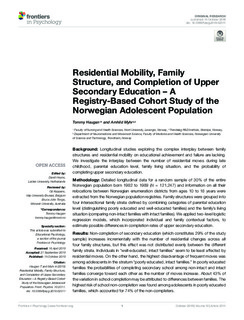| dc.contributor.author | Haugan, Tommy | |
| dc.contributor.author | Myhr, Arnhild | |
| dc.date.accessioned | 2019-12-13T11:34:34Z | |
| dc.date.available | 2019-12-13T11:34:34Z | |
| dc.date.created | 2019-10-16T14:33:22Z | |
| dc.date.issued | 2019 | |
| dc.identifier.issn | 1664-1078 | |
| dc.identifier.uri | http://hdl.handle.net/11250/2633174 | |
| dc.description.abstract | Background: Longitudinal studies exploring the complex interplay between family structures and residential mobility on educational achievement and failure are lacking. We investigate the interplay between the number of residential moves during late childhood, parental education level, family living situation, and the probability of completing upper secondary education.
Methodology: Detailed longitudinal data for a random sample of 30% of the entire Norwegian population born 1982 to 1989 (N = 121,247) and information on all their relocations between Norwegian enumeration districts from ages 10 to 18 years were extracted from the Norwegian population registries. Family structures were grouped into four intersectional family strata defined by combining categories of parental education level (distinguishing poorly educated and well-educated families) and the family’s living situation (comparing non-intact families with intact families). We applied two-level logistic regression models, which incorporated individual and family contextual factors, to estimate possible differences in completion rates of upper secondary education.
Results: Non-completion of secondary education (which constitutes 29% of the study sample) increases incrementally with the number of residential changes across all four family structures, but this effect was not distributed evenly between the different family strata. Individuals in “well-educated, intact families” seem to be least affected by residential moves. On the other hand, the highest disadvantage of frequent moves was among adolescents in the stratum “poorly educated, intact families.” In poorly educated families the probabilities of completing secondary school among non-intact and intact families converge toward each other as the number of moves increase. About 43% of the variation in school completion may be attributed to differences between families. The highest risk of school non-completion was found among adolescents in poorly educated families, which accounted for 74% of the non-completers.
Conclusion: We demonstrated underlying links between residential mobility and family structures on non-completion of upper secondary education. The adverse effect of frequent moves calls for attention in schools, public health agencies, and housing policies. The findings should be considered in a life course perspective, as the accumulation of unfavorable conditions during childhood and adolescence tends to constrict future prospects in terms of health and quality of life. | nb_NO |
| dc.language.iso | eng | nb_NO |
| dc.publisher | Frontiers Media | nb_NO |
| dc.title | Residential mobility, family structure, and completion of upper secondary education – A registry-based cohort study of the Norwegian adolescent population | nb_NO |
| dc.type | Journal article | nb_NO |
| dc.type | Peer reviewed | nb_NO |
| dc.description.version | publishedVersion | nb_NO |
| dc.source.volume | 10 | nb_NO |
| dc.source.journal | Frontiers in Psychology | nb_NO |
| dc.identifier.doi | 10.3389/fpsyg.2019.02311 | |
| dc.identifier.cristin | 1737648 | |
| dc.description.localcode | Copyright © 2019 Haugan and Myhr. This is an open-access article distributed under the terms of the Creative Commons Attribution License (CC BY). The use, distribution or reproduction in other forums is permitted, provided the original author(s) and the copyright owner(s) are credited and that the original publication in this journal is cited, in accordance with accepted academic practice. No use, distribution or reproduction is permitted which does not comply with these terms. | nb_NO |
| cristin.unitcode | 194,65,30,0 | |
| cristin.unitname | Institutt for nevromedisin og bevegelsesvitenskap | |
| cristin.ispublished | true | |
| cristin.fulltext | original | |
| cristin.qualitycode | 2 | |
